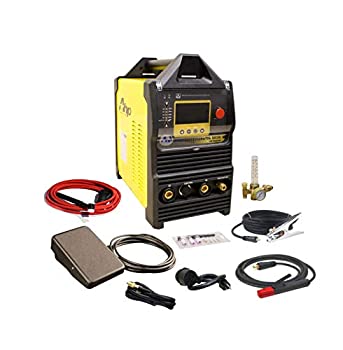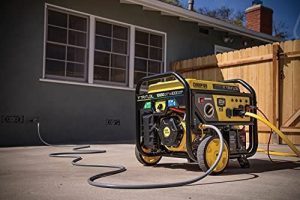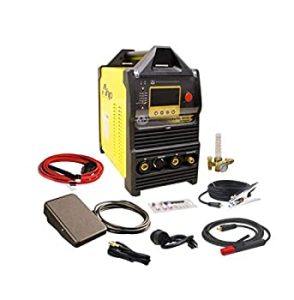Stick Welding is basically a slogan term used to describe Shielded Metal Arc Welding (SMAW) which is also known as manual metal arc welding (MMAW) or flux shielded arc welding. The use of the word stick is adopted from the fact that the electrode that is used to do the welding is designed as a “stick”. The electrode is composed of solid metal rod which is coated with metal powders and other compounds which are held into the surface by a binding agent.
Stick welding is a relatively uncomplicated process and it is the most common type of welding which uses simple equipment that is easy to learn. Generally, the process uses an electrode where the welding machine is connected to a power source to create a current that is either a direct current (DC) or alternating current (AC) in order to form an arc between the electrode and the material been welded providing a filler metal for the joint.
Stick welding is primarily used for heavy-duty iron and steel welds but it can also be used to weld other metals such as aluminum. It has wide application in repair and maintenance industries and in the construction of heavy steel and iron structures.
This article highlights important tips to guide you in creating high-quality stick welds and it also highlights common welding problems and how to correct them.
Stick Welding Basic Tips – Do’s and Don’ts
Choosing the Current setting
The current setting (DC or AC) is going to be determined by the type of electrode used. Make sure that you use the correct setting as per the task. A positive electrode provides good penetration while a negative electrode works well with thin metals. As such, the ideal amperage setting should be determined by the nature of the electrode, the welding position and the nature of the final weld.
The Right Electrode Size
As a general rule, for high deposit rates, you will require large electrodes welding at high currents. As such, for weld consistency, use the largest practical electrode. However, this should not be always the case especially when it comes to sheet metal where a burn through can happen. As such the recommended size for overhead and vertical weld is 3/16 inches while for low hydrogen welds, the most practical size is 5/32 inches. Additional, the size of the joint will determine the diameter of the electrode that is going to fit into the joint.
The Length of the Arc
Determining the length of the arc is important to every stick welder. Different electrodes and different applications will require different arc length which at all times should never exceed the diameter of the electrode.
The Angle of Travel
Different welding positions employ different techniques to move the electrode in the intended direction, in relation to the angle of travel. Vertical welding moves in an upward manner and it use the push technique that requires that you tilt the electrode in the opposite direction at an angle of 15 degrees.
Flat and horizontals positions are the easiest positions to weld as they use the drag technique which requires that you place the electrode perpendicular to the welding joint.
Clean and Dry up the Joint before Welding
It is important for you to remove any rust, paint, moisture or oil from the surface of the joint so as that you can attain the intended travel speed. This will also help you to deal with other issues such as porosity which tends to weaken the weld. Alternatively, you can use certain brands of high-speed electrodes to penetrate through the substances, deep into the metal.
Don’t Reuse an Electrode
If you want a clean weld that is free from porosity try as much as possible not to use a partially used electrode for your subsequent weld. As such you should always prioritize quality and not factor the extra cost as much.
Have the Necessary Finishing Supplies
Consider having all the necessary supplies for a good looking and neat stick weld. They include sandpaper, angle grinder, and a chipping hammer which will come in handy in doing some final touches and also help in the clean-up process when you are done welding.
Stick welding problems and Troubleshooting Tips
There are quite a number of problems that you are bound to encounter while trying to get used to the stick welding. It is part of the learning process which is why you should learn different tricks to help you get out of messy situations and perfect your art of welding.
Wet electrodes
Sometimes you may experience some rough arc action despite the fact that the current and polarity settings are within the manufacturer’s recommendations. This could be as a result of wet electrodes. If this is the case, you should substitute the electrodes with dry ones and in order to prevent a recurrence, you should keep all electrodes in a heated cabinet.
Improper Fusion
A proper fusion is when the weld is attached strongly to the walls of the joint resulting into a solid bond across the joint. Improper fusion is physically visible and it has to be dealt with in order for you to have a sound weld. For you to correct this improper fusion, pass a higher currency and make sure that the joint is clean. If this does not solve the problem, try an alternative solution like the weave technique to fill up the gap.
Wandering arc
An arc can wander from the intended direction especially with DC welding resulting from stray magnetic fields. This is can be a great concern with high currents and when welding at complex joints. The solution is switching to AC to counter the action. You can try to use low currents and if this does not work try to reduce the arc length or use smaller electrodes.
Shallow Penetration
This is simply the depth of the welder and it is not normally visible. Penetration to the bottom of the base metal is necessary for sturdy welds. Slower travel or higher currents can help to counter shallow penetration. You can also use a small electrode to dig deep into narrow grooves.
Cracking
Cracking is common phenomena and it can occur at any point throughout the weld. Most cracks are as a result of high content of sulfur, carbon or alloy in the base metal and it can potentially lead to failure of the entire project. Low hydrogen electrodes are known to significantly reduce the risk of cracking. You can also try and reduce penetration if there is a risk of cracking.
Conclusion
By following this guideline, you will be on the correct path of creating high-quality welds even as a beginner welder. Clean your working material, choose the arc length, the weld speed, the correct electrode and you are sure that you will be starting off on the right foot. Being able to identify a problem and being able to troubleshoot will go a long way in ensuring that your stick welds are close to perfection.










